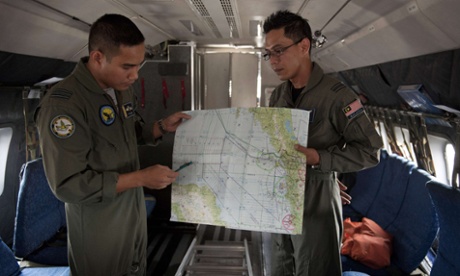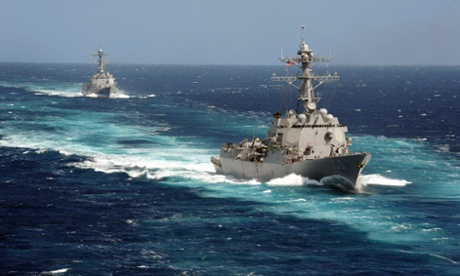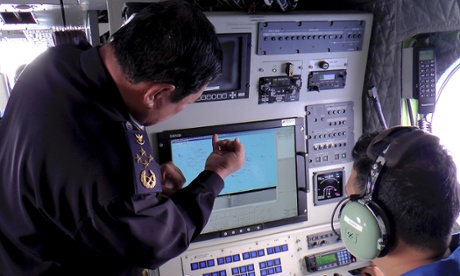- Missing Malaysian plane’s “systematic” communication shutdown suggests foul play
ABC Entertainment News | ABC Business News
MH370: Radar suggests plane deliberately flew west – live updates
LIVE
- Malaysia open minded to claims plane changed course
- Search extended into Indian Ocean
- Operation now involves 57 ships 48 aircraft
- What to believe? Clarifying conflicting media reports
- Plane disappearances: a brief history
- Malaysia Airlines missing plane: one week on - in pictures
- Read the latest summary
Indian aircraft have searched over the Andaman and Nicobar Islands, after suggestions that the missing plane last headed towards the heavily forested archipelago, according to Reuters.
Popular with tourists and anthropologists alike, the islands form India’s most isolated state. They are best known for dense rainforests, coral reefs and hunter-gatherer tribes who have long resisted contact with outsiders.
Two sources told Reuters the unidentified aircraft appeared to be following a commonly used navigational route that would take it over the islands.
The Indian Navy has deployed two Dornier planes to fly across the island chain, a total area of 720 km (447 miles) by 52 km), Indian military spokesman Harmeet Singh said in the state capital, Port Blair. So far the planes, and a helicopter searching the coast, had found nothing.
“This operation is like finding a needle in a haystack,” said Singh, who is the spokesman for joint air force, navy and army command in the Andaman and Nicobar islands.
The Defence Ministry said the Eastern Naval Command would also search across a new area measuring 15 km by 600 km along the Chennai coast in the Bay of Bengal.
The shape of this area, located 900 km west of Port Blair, suggested the search was focusing on a narrow flight corridor.

The USS Kidd is en route to the western tip of the Strait of Malacca to aid the search at the request of the Malaysian government, writes the Guardian’s US security editor Spencer Ackerman.
It left from the Gulf of Thailand yesterday and the Navy expects it will be in the Strait by Saturday, according to navy spokeswoman Lauryn Dempsey.Additionally, a P8 Poseidon surveillance plane is also on its way to the area, flying from Kadena Air Force Base in Japan.These are the only planned US military assets aiding the search at the moment. The USS Pinckney, which was in the Gulf of Thailand to aid the search,
has now returned to the Strait of Singapore for pre-planned maintenance.

The French aviation site Air Info has a more detailed map of the missing plane possible flight path based on that Reuters story.
The Chinese are joining the westward focus of the search. The marine patrol ship Haixun 31 is heading for the Strait of Malacca, according to the state news agency Xinhua.
Summary
Here’s a roundup on the latest on the search operation for the missing plane.
- The Malaysian authorities have indicated they are open minded to reports which cite US officials, suggesting the missing plane change course and headed west. The acting transport minister Hishammuddin Hussein confirmed that the search has extended into the Indian Ocean.
- Radar and satellite information from other countries, including the US, is now being shared with Malaysia. This is currently being “digested,” Hussein said.
- Military radar-tracking evidence suggests the plane was deliberately flown across the Malay peninsula towards the Andaman Islands, according to Reuters. Its sources said the plane appeared to have flown between navigational waypoints west of Malaysia indicating it was being flown by someone with aviation training.
- Rolls-Royce has issued a statement denying that its engines sent out signals from the missing aircraft after it vanished from air traffic control screens. A team of experts from the UK, including staff from Rolls-Royce is due to arrive in Malaysia to help with the investigation.
- The Wall Street Journal claims the search is now focused hundreds of miles west from the plane’s original flight path based on “pings” picked up by satellite. The White House said that an unspecified “possible piece of information, or pieces of information, has led to the possibility that a new search area may be opened up over the Indian Ocean”.
- There has been no confirmed sighting of debris from MH370 almost a week after it disappeared with 239 passengers on board. The search operation now involves 57 ships, 48 aircraft, and 13 countries.
Transponder
Hishammuddin confirmed that the investigators are examining the possibility that the plane’s transponder was deliberately shut down.
Asked about the transponder he said: “There are four or five possibilities which we are exploring. It could have been done intentionally, it could be done under duress, it could have been done because of an explosion. That’s why I don’t want to go into the realm of speculation. We are looking at the all the possibilities.”
He confirmed that crew were being investigated.
Updated
Data sharing
Malaysia now appears to have access to military data from other countries, particularly the US, which might help explain why the authorities now seem more open to reports that the missing plane was detected hours after it lost contact with air traffic control.
The Wall Street Journal claims the search is now focused hundreds of miles west from its original flight path based on “pings” picked up by satellite.
New data from other countries is being “digested”, Hishammuddin Hussein confirmed. He added that he hoped to have more confirmation of the data over the next couple of days.
The WSJ reported:
The satellites also received speed and altitude information about the plane from its intermittent “pings,” the people said. The final ping was sent from over water, at what one of these people called a normal cruising altitude. They added that it was unclear why the pings stopped. One of the people, an industry official, said it was possible that the system sending them had been disabled by someone on board.The people, who included a military official, the industry official and others, declined to say what specific path the transmissions revealed. But the U.S. planned to move surveillance planes into an area of the Indian Ocean 1,000 miles or more west of the Malay peninsula where the plane took off, said Cmdr. William Marks, the spokesman for the US Seventh Fleet.
Updated
Singapore Today has retweeted a map plotting the possible flight path as detailed by military radar cited by Reuters sources.
In their press conference the Malaysian authorities stressed that this possible data was not confirmed. Hishammuddin said: “If we can confirm that is actually MH370, then we can move all our assets from the South China Sea to the strait of Malacca. At the moment I’m not in a position to do that.”
Updated
UK experts due in Malayia
The civil aviation chief Azharuddin Abdul Rahman told the press conference aviation experts from the UK, including from Rolls-Royce, were due to arrive in Malaysia to help in the investigation. “They indicated that they are studying the possibility of satellite communication, and will share it with us,” he said.
Updated
Rolls-Royce
As Hishammuddin mentioned, Rolls-Royce has issued a statement denying that its engines sent out signals from the missing aircraft after it vanished from air traffic control screens.
The statement, which was also sent to the Guardian, said:
Rolls-Royce continues to provide its full support to the authorities and Malaysia Airlines. Rolls-Royce concurs with the statement made on Thursday 13 March by Malaysia’s transport minister, Hishammuddin Hussein, regarding engine health monitoring data received from the aircraft.
During that press conference Hishammuddin quoted Rolls-Royce saying that a report in the Wall Street Journal claiming the plane had sent signals hours after it lost contact with air traffic control were inaccurate. The WSJ has since published a correction saying the signals came from a separate communication device from the engines.
In a preamble to its statement Rolls-Royce also said:
We are treating this as if it were already a formal investigation and that means we are unable to share the information with you that we have shared with the authorities in Malaysia as it must be treated as confidential. It also means that we needed to ensure that the authorities were aware before we made any statement.

Updated
Full text of press statement
We are now entering the seventh day of the search for MH370. There are currently 57 ships and 48 aircraft in the search. Thirteen countries are now involved.
Our priority remains finding the plane. We are following all leads, and we continue to work closely with our international partners. We are grateful for the support of our friends and neighbours, who continue to assist us by sharing their data and their resources as we search for MH370. I speak for the Malaysian people when I say that our hearts are with the families and the friends of those on board the plane.New information
There has been a lot of media speculation today after comments from unnamed US officials suggested the plane may have travelled for some time after losing contact.As is standard procedure, the investigation team will not publicly release information until it has been properly verified and corroborated with the relevant authorities. Nor do we want to be drawn into specific remarks that unnamed officials have reportedly made to the media.
Since Sunday, we have worked closely with our international partners, including the US team, whose officials have been here on the ground in Kuala Lumpur.
Since Wednesday, the Malaysian investigating team have shared more detailed information, as it became available, for verification.The international team are currently working on verifying that detailed information, but we have nothing to confirm at the moment.Widening of the investigation
The aircraft is still missing, and the search area is expanding. Two days ago, the search area was widened to include the Andaman Sea.
Together with our international partners, we are now pushing further east into the South China Sea, and further into the Indian Ocean.
We want nothing more than to find the plane as quickly as possible. But the circumstances have forced us to widen our search.
A normal investigation becomes narrower with time, as new information focuses the search. But this is not a normal investigation. In this case, the information we have forces us to look further and further afield.Engine data
Yesterday, we rejected a media report in which unnamed officials said that engine data showed the plane had kept flying for hours after last contact. We checked with Boeing and Rolls-Royce, who said the reports were not true. Today Rolls Royce released a statement saying, and I quote, ‘Rolls-Royce continues to provide its full support to the authorities and Malaysia Airlines. Rolls-Royce concurs with the statement made on Thursday 13 March by Malaysia’s transport minister regarding engine health monitoring data received from the aircraft.’Oil slick
Yesterday authorities sighted two oil slicks in the South China Sea, 60 nautical miles south of the last point of contact with MH370.
The first slick was investigated and analysed and found to contain tiny traces of jet fuel. No debris was found in the vicinity. We do not believe the slick is linked to MH370.Samples from the second slick were investigated and analysed and did not contain jet fuel.Concluding remarks
The investigation team is following all leads that could help locate the missing aircraft. When we receive new information, and it has been verified, we act accordingly. Wherever there is a possibility, we have a duty to investigate it.
From the beginning of the crisis, we have worked hand-in-hand with all the relevant authorities, including international agencies, experts, and the aircraft manufacturers.
We have daily technical meetings with all the key players. We have followed the protocols set out by the International Civil Aviation Authority. We have been in regular contact with our neighbouring countries. And we have welcomed all international offers of assistance. We are committed to one aim: finding MH370.
Updated
The press conference has come to an end. Once again the Malaysian authorities offered little new information about the search for the plane and no breakthrough.
But today the acting transport minister appeared more open minded to new theories, in particular the suggestion that the plane may have been heading for the Indian Ocean.
Updated
Hishammuddin has not ruled out raiding homes of crew members of the missing plane. “If investigation requires searching the pilots’ homes, it will be done,” the acting transport minister said.
Updated
Hishammuddin insisted conflicting information about the missing plane was coming from external speculation, not the Malaysian government.
Updated
This map shows the possible new flight path of the missing plane if Reuters sources are correct.
Updated
Hishammuddin again said the investigators could not rule out hijacking. All possibilities are being examined, he repeated.
Updated
On the possible turn back, Hishammuddin repeated that this was still only a “possibility”. He said: “That has not changed.”
Updated
Malaysia’s defence and acting transport minister Hishammuddin Hussein has confirmed that the search has been extended into the Indian Ocean.
Speaking at a press conference he reiterated that the missing aircraft’s engines did not send out signals after it lost contact with air traffic control.
Updated
Radar shows plane flew west
Reuters has an intriguing new story which might explain why the search is currently focusing on the Indian Ocean. It says radar suggests the plane was deliberately flown west after losing contact with air traffic control. Under an exclusive tag, it says:
Military radar-tracking evidence suggests a Malaysia Airlines jetliner missing for nearly a week was deliberately flown across the Malay peninsula towards the Andaman Islands, sources familiar with the investigation told Reuters.Two sources said an unidentified aircraft that investigators believe was flight MH370 was following a route between navigational waypoints – indicating it was being flown by someone with aviation training – when it was last plotted on military radar off the country’s north-west coast.The last plot on the military radar’s tracking suggested the plane was flying towards India’s Andaman Islands, a chain of isles between the Andaman Sea and the Bay of Bengal, they said.Waypoints are geographic locations, worked out by calculating longitude and latitude, that help pilots navigate along established air corridors.A third source familiar with the investigation said inquiries were focusing increasingly on the theory that someone who knew how to fly a plane deliberately diverted the flight, with 239 people on board, hundreds of miles off its intended course from Kuala Lumpur to Beijing.“What we can say is we are looking at sabotage, with hijack still on the cards,” said that source, a senior Malaysian police official.All three sources declined to be identified because they were not authorised to speak to the media and due to the sensitivity of the investigation.Officials at Malaysia’s ministry of transport, the official point of contact for information on the investigation, did not return calls seeking comment.Malaysian police have previously said they are investigating whether any passengers or crew had personal or psychological problems that might shed light on the mystery, along with the possibility of a hijacking, sabotage or mechanical failure.The comments by the three sources are the first clear indication that foul play is the main focus of official suspicions in the Boeing 777’s disappearance.As a result of the new evidence, the sources said, multinational search efforts were being stepped up in the Andaman Sea and also the Indian Ocean …The fact that the aircraft – if it was MH370 – had lost contact with air traffic control and was invisible to civilian radar suggested someone on board had turned its communication systems off, the first two sources said.They also gave new details on the direction in which the unidentified aircraft was heading – following aviation corridors identified on maps used by pilots as N571 and P628. These routes are taken by commercial planes flying from south-east Asia to the Middle East or Europe and can be found in public documents issued by regional aviation authorities.In a far more detailed description of the military radar plotting than has been publicly revealed, the first two sources said the last confirmed position of MH370 was at 35,000 feet about 90 miles (144km) off the east coast of Malaysia, heading towards Vietnam, near a navigational waypoint called Igari. The time was 1.21am.The military track suggests it then turned sharply westwards, heading towards a waypoint called Vampi, north-east of Indonesia’s Aceh province and a navigational point used for planes following route N571 to the Middle East.From there, the plot indicates the plane flew towards a waypoint called Gival, south of the Thai island of Phuket, and was last plotted heading north-west towards another waypoint called Igrex, on route P628 that would take it over the Andaman Islands and which carriers use to fly towards Europe.The time was then 2.15am. That is the same time given by the air force chief on Wednesday, who gave no information on that plane’s possible direction.The sources said Malaysia was requesting raw radar data from its neighbours Thailand, Indonesia and India, which has a naval base in the Andaman Islands.

Updated
Bomohs
In its statements Malaysia’s transport ministry also insisted the government had nothing to do with “bomohs” or shamans at Kuala Lumpur airport who have prompted much interest on social media. The bomohs have been performing rituals at the airport to help find the plane.

Updated
Malaysia 'following all leads'
The Malaysian authorities now appear to have a more open mind to reports that the plane sent out signals hours after it lost contact with air traffic control. In yesterday’s press conference they tersely dismissed such reports as “inaccurate”. But now the ministry of transport has tempered that stance.
In its latest statement it said:
Regarding overnight reports in the US media, quoting unnamed US officials:
The investigation team is following all leads that may help locate the missing aircraft. We continue to work closely with the US team, whose officials have been on the ground in Kuala Lumpur to help with the investigation since Sunday.
As is standard procedure, the investigation team will not publicly release information until it has been properly verified and corroborated.
The statement also confirmed that the Indian air force was participating in the search, and that Vietnam was still involved.
And the ministry released a statement from the Chinese embassy confirming that satellite images from Sunday of possible ”debris” from the plane were released in error. No trace of the plane was found at the site. The embassy said:
The publication of the satellite image is an accident – a personal behaviour to put it on the website of SASTIND. The government neither authorised nor endorsed the behaviour which is now under investigation. The image is not been confirmed as connected with the plane.
Updated
Opening summary
Welcome to our continuing coverage of the search for the missing Malaysia Airlines plane almost a week after it disappeared over the South China Sea with 239 people on board.
Here’s a summary of the latest developments:
- The US has suggested that the search has been extended to the Indian Ocean after the Pentagon said it was sending a destroyer to the area. The White House said that an unspecified “possible piece of information, or pieces of information, has led to the possibility that a new search area may be opened up over the Indian Ocean”.
- Unnamed US officials continue to be quoted insisting that flight 370 sent out automatic status transmissions for hours after the plane lost contact with ground control. The Malaysian authorities say such claims are inaccurate.
- The Wall Street Journal has issued a clarification to point out that its claim that the plane may have flown on for hours is based on a different signals system from the plane’s Rolls-Royce engines. In a correction to its original story it said: “An earlier version of this article incorrectly said investigators based their suspicions on signals from monitoring systems embedded in the plane’s Rolls-Royce PLC engines and described that process.”
- Vietnam has “downgraded but not stopped” its search effort for the plane. A Vietnamese spokesman, Lt Col Nguyen Ngoc Son, said the status of the hunt had been switched from “emergency to regular”.
